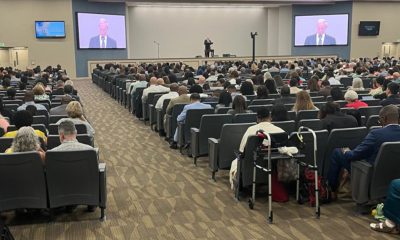Advice
Tips to be Fit: Most germs won’t hurt us, but 1,400 can
THE PHILADELPHIA TRIBUNE — Did you know there are over 65,000 known germs, but only about 1,400 cause disease? The four major types of germs are bacteria, viruses, fungi and protozoa. They can infect our bodies and cause disease. There is a difference between infection and disease. We can be infected without being diseased.
Did you know there are over 65,000 known germs, but only about 1,400 cause disease?
The four major types of germs are bacteria, viruses, fungi and protozoa. They can infect our bodies and cause disease. There is a difference between infection and disease. We can be infected without being diseased.
An infection is the first step, which occurs when bacteria, viruses or other microbes that cause disease enter our body and begin to multiply. Disease is when the cells in our body are damaged as a result of the infection, and symptoms of an illness appear.
Most germs won’t hurt us. Our immune system protects us against infections. But germs may mutate and breach the immune system. Knowing how germs work will reduce your risk of infection.
Bacteria are one-celled organisms. They are visible only with a microscope. Not all bacteria are harmful. Some bacteria live in our body and are helpful, such as Lactobacillus acidophilus, which lives in our intestines and helps us digest food, destroys some disease-causing organisms and provides nutrients.
Disease-causing bacteria will produce toxins that can damage cells and make you ill. Some bacteria directly invade and damage cell tissues. Some infections caused by bacteria include strep throat, tuberculosis and urinary tract infections.
Viruses are much smaller than our cells. Viruses are organisms that contain only genetic material. To reproduce, viruses invade cells in our bodies and change how our cells work. Most host cells are eventually destroyed during this process, which can kill us.
Viruses are responsible for causing numerous diseases, including AIDS, the common cold, Ebola hemorrhagic fever, genital herpes, influenza, measles, chickenpox and shingles.
Antibiotics for bacteria have no effect on viruses.
There are many varieties of fungi. Fungi are organisms that are reproduced by spores. We eat a number of them, such as mushrooms. The mold that forms the blue or green veins in some types of cheese are also fungi. So is yeast, the ingredient that makes bread rise.
Some fungi can also cause illness. Fungi are also responsible for skin conditions such as athlete’s foot and ringworm.
Protozoans
A protozoan is a single-celled organism that acts like a tiny animal. Protozoans eat other microbes for food. A few types of protozoans are found in our intestinal tract and are harmless.
Protozoans spend part of their life cycle outside the host. Protozoans live in food, soil, water and insects. Some protozoans invade our bodies through food or water we consume.
Some cause diseases such as giardia, malaria and toxoplasmosis. The protozoan that causes malaria is transmitted by a mosquito.
Infectious diseases
An easy way to contract most infectious diseases is by coming in contact with a person, animal or object that has the infection. Three ways infectious diseases can be spread through direct contact are:
Person to person: This is the most common way for infectious diseases to spread is when a person infected with the bacterium or virus touches, kisses, coughs on or sneezes on someone who isn’t infected. The germs can also spread through the exchange of body fluids from sexual contact. People who pass germs may have no symptoms of their disease.
Animal to person: Getting bitten or scratched by an infected animal can make you sick. It can be fatal in extreme situations. Handling animal waste can make you sick. You can acquire a toxoplasmosis infection by scooping your cat’s litter.
Mother to unborn child: A pregnant woman can pass germs that cause infectious diseases to her unborn baby. The germs can pass through the placenta connecting mother and baby. Germs in the vagina can be transmitted to the baby during birth.
Bacteria, viruses, fungi and protozoa can enter our bodies through:
- Skin contact or injuries.
- Inhaling airborne germs.
- Consuming contaminated food or water.
- Tick or mosquito bites.
- Sexual contact.
You should get medical care if you suspect that you have an infection and you have experienced any of the following:
- An animal or human bite
- Difficulty breathing
- A cough lasting longer than a week.
- Periods of rapid heartbeat.
- A rash, especially if accompanied by a fever.
- Blurred vision or other difficulty seeing.
- Persistent vomiting.
- An unusual or severe headache.
- Reducing risk of infection
The CDC recommends the following to help reduce your risk of becoming infected:
Wash your hands. This is especially important before and after preparing food or drinks, before eating or drinking, after using the toilet, and after removing soiled clothes or shoes. Try not to touch your eyes, nose or mouth with your hands, as that’s a common way germs enter the body. Soap and water work well to kill germs. Wash for at least 20 seconds and rub your hands briskly. Disposable hand wipes or gel sanitizers also work well. Gel sanitizers and hand wipes should be 70% alcohol-based.
Get vaccinated. Immunization can drastically reduce your chances of contracting many diseases. Make sure to keep up to date on your recommended vaccinations, as well as your children’s.
Stay home when ill. Don’t go to work if you are vomiting, have diarrhea or have a fever. Don’t send your child to school if he or she has these signs and symptoms, either.
Prepare food safely. Keep counters and other kitchen surfaces clean when preparing meals. Cook foods to the proper temperature using a food thermometer to check for doneness. For ground meats, that means at least 160 degrees F (71 C); for poultry, 165 F (74 C); and for most other meat, at least 145 F (63 C). In addition, promptly refrigerate leftovers. Don’t let cooked foods remain at room temperature for extended periods of time.
Practice safe sex. Always use condoms if you or your partner has a history of sexually transmitted infections or high-risk behavior.
Don’t share personal items. Use your own toothbrush, comb and razor. Avoid sharing drinking glasses or dining utensils.
Travel wisely. If you’re traveling out of the country, talk to your doctor about any special vaccinations.
If you work out in a gym, be careful. You are exposed to a lot of people. You are using equipment that was just used. Clean the padding before you use it. More than 50% of healthy persons have Staphylococcus aureus living in or on their nasal passages, throats, hair and skin.
Swimming can be dangerous, too. The average swimmer contributes at least 0.14 grams of fecal material to the water within the first 15 minutes of entering the pool. Showering with soap before swimming helps stop the spread of germs by removing fecal material from the body.
You should also make sure your gym has good air circulation. We can’t wash the air in a gym, but the exchange of air should be good.
Pets and other animals
Got a pet? Be careful. To reduce the risk of getting sick from germs your pets may carry, always wash your hands after:
• Touching or playing with your pet.
• Feeding your pet or handling pet food.
• Handling pet habitats or equipment (cages, tanks, toys, food and water dishes, etc.)
• Cleaning up after pets.
• Leaving areas where animals live (coops, barns, stalls, etc.), even if you did not touch an animal.
Going to the zoo this season? Try to make it safe:
• Don’t walk and eat. Your hands will touch a lot of contaminated objects.
• Don’t let your little one use a pacifier. They touch that pacifier with everything. They may even share it with an animal.
• Wipe off any seating or table you use in the zoo.
• Don’t feed the animals from your hand.
• If you have an open wound, cover it completely.
• Try not to come into contact with any animal waste. It’s teaming with germs.
This article originally appeared in The Philadelphia Tribune.
Activism
Leading with Action, Love and Data Points: Six Questions for the California Black Women’s Collective
“Black Women in California have always had to be active participants in the labor market, but this report showcases the need for fair and just wages even for those of us with higher educational attainment,” said Kellie Todd-Griffin, President and Chief Executive Officer of the California Black Women’s Collective.

By Edward Henderson | California Black Media
The California Black Women’s Collective (CABWC) is a sisterhood of women from different professional backgrounds aiming to uplift and address the issues impacting Black women and girls in the state. They approach problem-solving with a range of expertise — from politics, business, and community advocacy to the arts, entertainment, social justice activism, and more.
Earlier this month, the organization released a wage report focused on Black women’s earnings in California titled “Pay Me What I am Worth.”
“Black Women in California have always had to be active participants in the labor market, but this report showcases the need for fair and just wages even for those of us with higher educational attainment,” said Kellie Todd-Griffin, President and Chief Executive Officer of the California Black Women’s Collective.
“Black Women in California wages are below the state mean wage and make less than most of their female counterparts in every category,” continued Todd-Griffin. “We must take action now.”
CABWC’s Black Girl Joy Festival is an event designed to uplift Black Women and Girls in a safe space while learning and having fun. The festival includes free workshops that prepare women for college, dancing, self-defense training, health screenings, yoga, arts & crafts, and food vendors.
The Collective’s Empowerment Institute, launched in collaboration with the Los Angeles-based research firm EVITARUS, produces the annual California Black Women’s Quality of Life Survey.
California Black Media spoke with Todd-Griffin about the organization’s impact, challenges it faces and some of its near-term plans.
What does your organization do to improve the lives of Black people in California?
The California Black Women’s Collective Empowerment Institute’s uplifts the issues and voices of Black Women and Girls in California through our programming. That includes the Black Women’s Worker Initiative that helps Black Women prepare for public section and non-traditional careers. Other initiatives are the CA Black Women’s Leadership Development Certificate program at CSU Dominguez Hills; Black Girl Joy Festival for middle and high school students; Conversations for Black Women, etc. Our targeted research also uncovers solutions to the toughest challenges Black women and girls face.
What was your greatest success over the course of the last year?
We released the first-ever California Black Women’s Quality of Life Survey. This study collected insights from 1,258 Black women voters across California to understand their economic state, most pressing concerns, their attitudes toward policymakers, and their experiences and issues in California.
In your view, what is the biggest challenge Black Californians face?
Black Californians, especially Black Women, continue to be left out of the conversation when it comes to building meaningful change to improve the lives of those who struggle the most.
What was your organization’s biggest challenge?
Our biggest challenge over the last year was transitioning from a volunteer driven entity, the California Black Women’s Collective, to creating a non-profit organization, the California Black Women’s Collective Empowerment Institute.
Does your organization support or plan to get involved in the push for reparations in California?
Absolutely!
How can more Californians of all backgrounds get involved in the work you’re doing?
We are on all the social media channels. They can also visit our website, www.CABlackWomensCollective.org.
Activism
The Silent Struggle of Pregnancy Loss
It is a tragedy that Black women’s odds of pregnancy loss are much higher than the general population. It’s even more tragic that there is a Black woman reading this article who has experienced pregnancy loss and has suffered in silence. There are an array of feelings associated with pregnancy loss, and women often feel alone and isolated in these feelings believing that no one understands what they are going through.

By Narissa Harris, LMFT
The topic and contents of this article may be difficult for some readers. Yet, it is of paramount importance to shed light on the silent struggle of pregnancy loss experienced by countless women.
During the holiday season, we often assume everyone is in a festive, happy mood. However, this time of year is filled with mixed emotions and can be especially difficult for Black women, who are 2-3 times more likely to experience a pregnancy loss compared to other women. Pregnancy loss (the death of an unborn baby/fetus during pregnancy) is experienced by 10-15% of women and doubles to 20-30% for Black women. Additionally, Black women are 3 times more likely to have a stillbirth in comparison to other women.
It is a tragedy that Black women’s odds of pregnancy loss are much higher than the general population. It’s even more tragic that there is a Black woman reading this article who has experienced pregnancy loss and has suffered in silence. There are an array of feelings associated with pregnancy loss, and women often feel alone and isolated in these feelings, believing that no one understands what they are going through.
Whether you are aware that someone has experienced pregnancy loss, or you have experienced pregnancy loss yourself, we must be sensitive and supportive to the women in our lives during this time of year. I encourage the following:
#1 – Don’t ask a woman about her uterus!
Yes, I know this is blunt and harsh, but it is important to be mindful of the trauma that may be triggered when asking a woman when she plans to have a baby. I will never forget being at a holiday party when a family member asked me when I was planning on having kids, unaware that I experienced my 3rd pregnancy loss just 6 weeks prior. It was triggering, upsetting, and annoying. While my husband and I were eventually blessed with 2 healthy children, I share my experience to reiterate the immediate and long-term harm caused by these types of invasive inquiries.
#2 – Connect with a supportive community!
If you are someone who has experienced a pregnancy loss or know a woman who has, it is vital to connect with a safe and supportive community even when everything is telling you (or that woman) to isolate. While no one in the chapter knew that I was dealing with pregnancy loss at the time, my connection with the Bay Area Chapter of the Association of Black Psychologists (Bay-ABPsi) served as a healing and uplifting space for my grief/loss. I learned from Baba Dr. Wade Nobles, who describes babies as divine and the closest beings to God. I want you to remember that connecting with our spiritual community and ancestors can offer healing and support.
#3 – Never lose hope!
To the women who have experienced pregnancy loss, it’s easy to believe that a successful pregnancy will not happen but keep the hope. Take the time you need to grieve and release the baby (or babies), allowing your womb to heal. View the lost pregnancy in terms of a spirit with a Divine purpose, even if it was short-lived, with you being the vessel for that Divine purpose. Believe and prepare for your baby, who will survive and succeed beyond the womb to fulfill their Divine purpose!
Bay ABPsi is a healing resource committed to providing the Post Newspaper readership with monthly discussions about critical issues in Black Mental Health. Readers are welcome to contact us at bayareaabpsi@gmail.com and join us at our monthly chapter meetings every 3rd Saturday via Zoom.
Advice
BOOK REVIEW: “The Day After Yesterday: Resilience in the Face of Dementia”
Well into his twenties, Joe Wallace was asked to sit with his “Granddaddy Joe” while Wallace’s mother and grandmother ran errands. His grandfather was once a vibrant man, and he’d been Wallace’s “hero,” but Alzheimer’s had put a curtain of sorts between them, and Wallace was “so frightened to be left alone with him.” It didn’t take long for him to realize that day that his grandfather was full of stories, and it was “magical.” He applied the same kind of patience when his grandmother began to experience dementia, too, and this spurred Wallace to tell a story of his own with his camera.

By Terri Schlichenmeyer
Sometimes, Mom talks a lot of nonsense.
She talks in random syllables, half-jokes, thoughts that come out of her mouth backwards or mixed up. You try, she laughs, you laugh, pretending that you understand but you don’t. Mom has dementia and there’s nothing that’ll fix it, but you can read “The Day After Yesterday” by Joe Wallace and change the conversation.
Talk about your awkward encounters.
Well into his twenties, Joe Wallace was asked to sit with his “Granddaddy Joe” while Wallace’s mother and grandmother ran errands. His grandfather was once a vibrant man, and he’d been Wallace’s “hero,” but Alzheimer’s had put a curtain of sorts between them, and Wallace was “so frightened to be left alone with him.”
It didn’t take long for him to realize that day that his grandfather was full of stories, and it was “magical.” He applied the same kind of patience when his grandmother began to experience dementia, too, and this spurred Wallace to tell a story of his own with his camera.
The portraits he captured eventually became an exhibit, and this book.
“In the United States,” Wallace says, “one in three seniors suffers with Alzheimer’s or another dementia at the time of their death.” Nearly $700 billion dollars annually is spent caring for people with dementia. Alzheimer’s, as one of Wallace’s subjects points out, affects Black seniors more often than it does whites. For that matter, people with dementia need not be seniors: early-onset Alzheimer’s can affect someone in their early 20s.
Listen, Wallace’s subjects almost always say, and don’t hide a diagnosis of dementia. There’s no shame in it. Reach out to others who’ve received the diagnosis. Ask for help. Watch for suicidal thoughts and depression. Ask for stories, before they’re lost, and be honest about what’s going on. You can’t change the diagnosis, but you can change your attitude toward it.
It’s called The Long Goodbye for a reason – and yet, your loved one with dementia is still on this side of the sod and you know there’s still some there there. In “The Day After Yesterday,” you’ll get a new point-of-view, for both of you.
In his introduction interview, author Joe Wallace explains how he came to understand that “we could all do so much better” for those with cognitive disabilities, including Alzheimer’s, and why eliminating fear and awkwardness is essential. Readers will be quite taken by the then-and-now pictures and by the conversations Wallace captured.
But beware: this isn’t a book on caregiving or advice-giving. It’s a delightful, heartbreaking, tearful, surprising collection of profiles of everyday people in their own words, people who go with the flow and deal with tomorrow when it comes. Yes, you’ll find advice here, but it pales in comparison to the presence that Wallace’s subjects and their families exhibit.
This powerful book is great for someone with a new dementia diagnosis; it proves that life is not over yet. It’s likewise great for a caregiver, gently ushering them toward grace.
Get “The Day After Yesterday. It’s time for a talk.
“The Day After Yesterday: Resilience in the Face of Dementia” by Joe Wallace
c.2023, The MIT Press. $34.95; 157 pages.
-

 Arts and Culture3 weeks ago
Arts and Culture3 weeks agoRooted in Tradition: The Intricate History of Black Hair Braiding
-

 Bay Area4 weeks ago
Bay Area4 weeks ago“I Will Not Be Bullied,” Says Oakland Mayor Sheng Thao
-

 Bay Area2 weeks ago
Bay Area2 weeks agoPG&E Increases Rates While Bay Area Households Are Struggling to Stay Afloat
-

 Business3 weeks ago
Business3 weeks agoGov Newsom: Raising Fast Food Minimum Wage to $20 Pays Off as Jobs Multiply in Industry
-

 Activism4 weeks ago
Activism4 weeks agoOpponents of Mayor Sheng Thao Are Calling on Her to Resign Following FBI Raid
-

 Community1 week ago
Community1 week agoHundreds Come to Jehovah’s Witnesses’ Assembly Hall for Three-Day Program of ‘Good News’ in Fremont
-

 Bay Area2 weeks ago
Bay Area2 weeks agoJuneteenth Mass Shooting Suspect Charge with Multiple Counts of Felony Assault by Alameda County DA Pamela Price
-

 Activism4 weeks ago
Activism4 weeks agoOakland Coliseum Sale to AASEG: A Model for Community Development and Inclusion























































